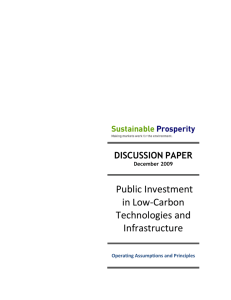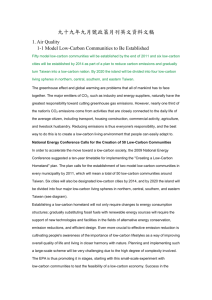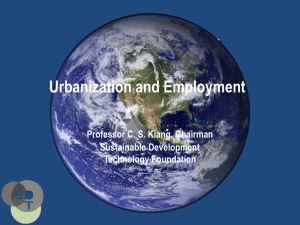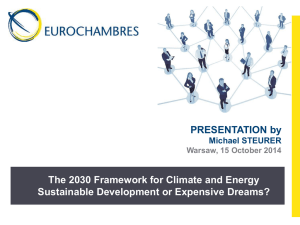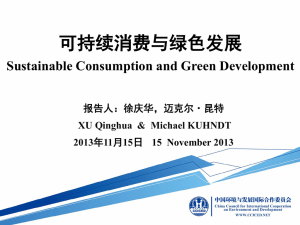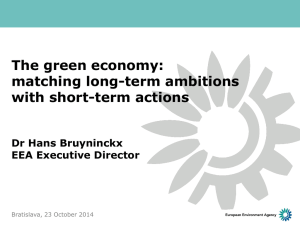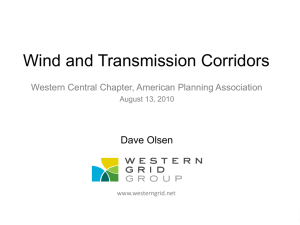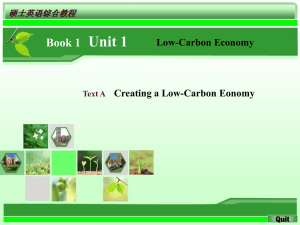CASS
advertisement
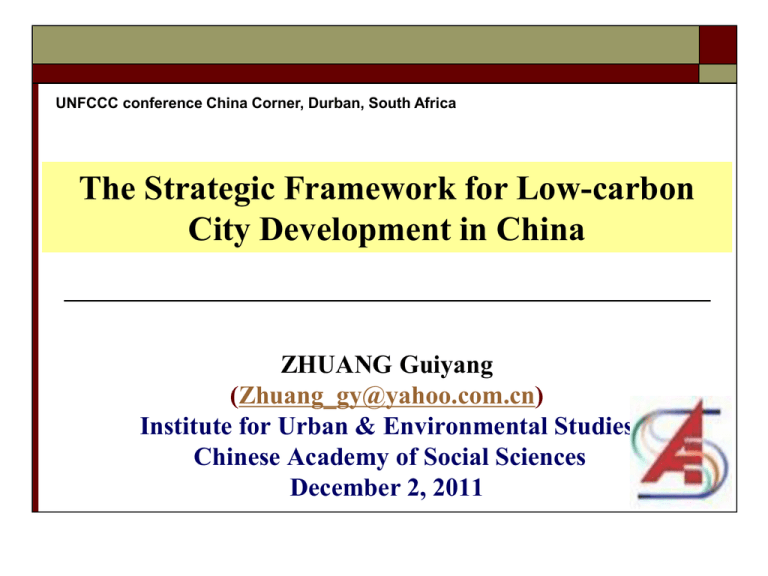
UNFCCC conference China Corner, Durban, South Africa The Strategic Framework for Low-carbon City Development in China ZHUANG Guiyang (Zhuang_gy@yahoo.com.cn) Institute for Urban & Environmental Studies Chinese Academy of Social Sciences December 2, 2011 Outline China’s Low-carbon Transformation Why Low-carbon City in China? Modes of Low-carbon City Construction in China Key points for Low-carbon City Development in 12th FYP Conclusions China’s Low-carbon Transformation A question of how to accelerate the process rather than one of whether or not China’s low-carbon development is not merely in response to global climate change, but also a necessity for lowcarbon green growth China has announced operational targets to achieve lowcarbon growth and transformation carbon intensity reduces 40%-45% by 2020 from 2005 level non-fossil energy consists 15% of primary energy consumption by 2020 forest carbon sink target Low-carbon Targets in the 12th five year plan: Energy intensity reduces 16% Carbon intensity reduces 17% Non-fossil energy consists 11.4% in 2015 (7.8% in 2009) Forest coverage rate reaches 21.66%(20.36% in 2010) Concept of Low-carbon Economy The concept of low-carbon economy put forward by UK is based on a hypothesis of post-industry development stage, emphasizing the absolute decoupling of economic growth and carbon emission As China's current industrialization and urbanization is still in development stage, "low-carbon economy"is not an absolute but a relative concept CASS definition: Low carbon economy refers to a form of economy that features a high carbon productivity, a high level of human development within a certain carbon emission constrains, aiming to realize the global shared vision of reducing GHG emissions Understanding Low-carbon Economy 核心特征(key characteristics of the concept) 低碳排放(low carbon-emission) 高碳生产力(high carbon-productivity) 高人文发展水平(high human development) 阶段性(progression step by step) 低碳转型的基础(key elements for assessment) 发展阶段(development stage) 资源禀赋(resource endowment) 消费模式(consumption pattern) 技术水平(technology level) Why Low-carbon City in China? Rapid urbanization now and in the coming decades The 12th FYP addresses urbanization as a central issue, and emphasizes on inclusive growth At cost of huge amount of energy and resource consumption Huge infrastructure investment needed To avoid long-term carbon lock-in Lots of co-benefits (addressing city “sickness”) Low transport efficiency/Traffic jams Air pollution Cities are surrounded by waste Return to original essence of city life: better city, better life An opportunity to gain advantage of first-mover Not only a popular slogan or a name card Bring jobs and investment Improve carbon competitiveness Challenges for China’s Urbanization Energy efficiency and CO2 emission restriction Urban land shortage During 11th FY, urban construction land use shortage is about 50% Water resource shortage Most cities are short of water, some lack water Motorization and air pollution Motor vehicles ownership reached 199 million, each year 20 million vehicles add to the total ownership(No.1 production and sale) Highly energy-consuming development mode Rapid urbanization stimulate more energy demand Garbage besieged cities Almost 2/3 China’s cities are surrounded by mountains of garbage. 1/4 cities have not enough places to dispose the trash Social problems Increasing income gap and urban poverty Modes of Low-carbon City Construction in China Low carbon city initiatives by individual municipal governments in China are self-motivated, experimental and fragmented, without a systematic and easily duplicable set of methodologies Experiment in selected area-- the Shanghai World Expo Start from unique industry-- Baoding new energy industry Establishes six industrial system including photovoltaic, wind power, electricity saving, electricity storage, power transmission and electric power automation Systematic Planning – Jilin city Follow low-carbon concept through the whole process from site selection, planning to the design, construction, operation to reduce carbon emissions from the source Identify the key industry from a number of industries, through which to pull effect to lead the entire industrial system to achieve lwo-carbon transition of the whole city Low-carbon pilot and demonstration by government The successful experiences will be summarized and promoted Low-carbon Pilot Provinces and Cities Notification released by NDRC in August 2010 Five provinces include Guangdong, Shannxi, Yunnan, Hubei and Liaoning Eight cities include Tianjin, Chongqing, Shenzhen, Xiamen, Hangzhou, Baoding, Guiyang and Nanchang Piloting tasks: compiling of low-carbon development plans (integrated local into 12th FYP), making relevant green development policies accelerating establishment of industry system featuring low carbon emissions establishing statistical and managing mechanism of GHGs advocating of green lifestyles and consumption Pilot Low-carbon Transport System Initiated by Ministry of Transportation in Feburary 2011 10 cities: Tianjin, Chongqing, Shenzhen, Xiamen, Hangzhou, Nanchang, Guiyang, Baoding, Wuhan and Wuxi Piloting tasks: establishing low carbon transport infrastructure application and dissemination of low carbon equipment optimizing transport organization mode and operation approach constructing smart traffic engineering perfecting transport related public information service establishing and perfecting transport carbon emission management system Comprehensive Demonstration on Financial Policies of Energy-saving and Pollution Reduction Initiated by NDRC and Ministry of Finance in June 2011 8 pilot cities: Beijing, Shenzhen, Chongqing, Hangzhou, Changsha, Guiyang, Jilin and Xinyu (in Jiangxi Province) Piloting tasks focus on: industrial de-carbonization (产业低碳化) cleaning transportation system(交通清洁化) greening building sectors (建筑绿色化) intensification to speed up service industry(服务集约化) reduction of main pollutants (污染减量化) enlarging scale of renewable energy(可再生能源利用规模化) Key Points for Low Carbon City Development in the 12th FYP Accelerating to establish and complete GHGs statistical and accounting system Carrying out overall low carbon pilot and demonstration Establishing carbon emission trading scheme step by step Setting overall working plan Establish voluntary emission reduction trading scheme Carrying out pilot carbon emission right trading Strengthening technology supporting system on carbon emission trading Vigorously advancing low carbon actions in whole society Pilot low carbon provinces and cities, industrial parks, communities, commerce, products, marine living carbon sequestration Demonstration engineering of industrial process GHGs control, CCUS technologies, saving and substitute engineering of high carbon emission products Public institutions, enterprises, public awareness International cooperation Low-carbon technology and experiences, south-south cooperation PDCA for Low Carbon City Development Plan Formulating low-carbon development plan with long-term vision and short-term target Detailed implementing action plan in key areas (plan and management, economy, buildings and transportation) Decision-making mechanism (public participation, government efficiency) Do Establish low-carbon economy leading group with mayor or party’s secretary as leader, set up low-carbon office to coordinate relevant issues Formulate supporting policies for low-carbon green growth Set up industrial system with low-carbon emission Build a statistical and management system for GHG emission Advocate the low-carbon living and consumption mode Pilot and demonstration Integrate low-carbon targets into local 12th FYP Check MRV and performance evaluation Act: Standardize solution Conclusions Low-carbon economy is both a theoretical issue and a practice issue, which requires theoretical guidance also requires practical solutions China’s low-carbon city is now at an exploring stage from theoretical system building to planning and construction practice Low-carbon city development planning should go ahead in advance, through pilot and demonstration to accumulate experience and promotion is a conventional approach for decision-making in China Establishment of energy and carbon emissions monitoring, statistics and evaluation system is a basic work for the city's low-carbon, green city development 15
